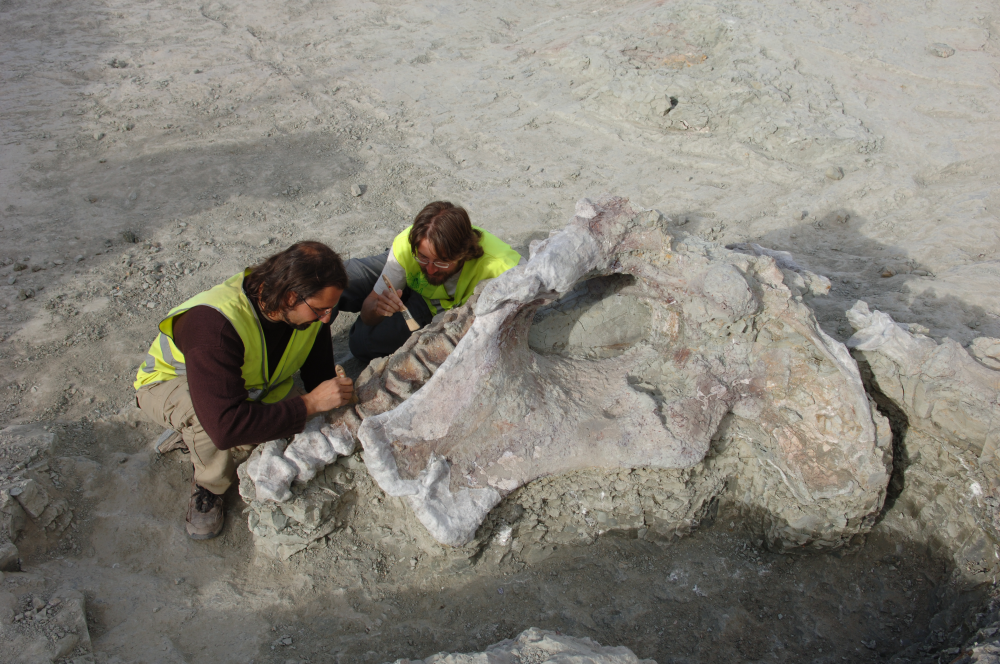It’s a good day for palaeontology fans as a team of scientists have announced the discovery of a new species of dinosaur. The fossils retrieved in Spain belonged to a titanosaur, the long-necked giants, and is between 70 to 75 million years old.
The prehistoric giant’s partial skeleton was found at the Lo Hueco fossil site in Cuenca, Spain. Its discovery inspired its name, Qunkasaura pintiquiniestra, which refers to Cuenca, the Spanish painter Antonio Saura, and Queen Pintiquiniestra who was a character from the 16th century book Amadis of Greece that features in the 17th century novel Don Quixote.
“Qunkasaura pintiquiniestra is a sauropod dinosaur, which corresponds to a group of herbivorous and quadrupedal dinosaurs,” explained lead author Pedro Mocho of the University of Lisbon, Portugal, to IFLScience.
“Sauropods are characterized by their long necks and tails, columnar limbs, and small head relative to their body size. In particular, Qunkasaura belongs to a group of sauropods named Titanosauria, and some members of these groups are featured by the presence of osteoderms, which partially covered their skin.”

The excavation of Qunkasaura pintiquiniestra at Lo Hueco.
Image credit: GBE-UNED
Titanosaurs are the only sauropods to have this dermal armor, and while they’re a relatively rare find, several have come from the Lo Hueco fossil site.
From the fossilized skeleton, the authors were also able to identify some skeletal features that are unique to Qunkasaura. These included bony projections on its neck bones and a hook-shaped thing sticking off the base of its spine.
This is the first time we discovered two distinct lineages of saltasauroids in the same fossil locality.
Pedro Mocho
Curiously, its tail shares a characteristic seen in a group of titanosaurs known as the aeolosaurines, which wouldn’t be so strange if it wasn’t that these dinosaurs are found way over in South America. The evolutionary relationships between Qunkasaura and aeolosaurines don’t show any relation, so it could be that this is a kind of convergent evolution where a shared skeletal feature has evolved independently in different lineages.
More locally, Qunkasaura joins the opisthocoelicaudine saltasaurids, a group of dinosaurs found on Laurasia, which is the ancient supercontinent that eventually split up to create North America, Europe, and Asia. Their close proximity to other dinosaurs like the lirainosaurines is reflected in the fossil diversity at Lo Hueco, and provides further insight into the evolution of European titanosaurs.

Size comparison for Qunkasaura pintiquiniestra with some colorful characters.
Image credit: GBE-UNED
“This is the first time we discovered two distinct lineages of saltasauroids in the same fossil locality,” added Mocho. “One of these groups named Lirainosaurinae is relatively well-known in the Iberian region, and they are characterized by species of small and medium size, which evolved in an insular ecosystem, i.e., Europe was a huge archipelago composed by several islands during the Late Cretaceous.”
“However, Qunkasaura belongs to another group of sauropods, which is represented in the Iberian Peninsula by medium-large sized species 73 million years ago. This suggests to us that they reached the Iberian Peninsula much later than other groups of dinosaurs.”
The study is published in Communications Biology.
Source Link: New Species Of Titanosaur Found In Spain Dates Back 72 Million Years